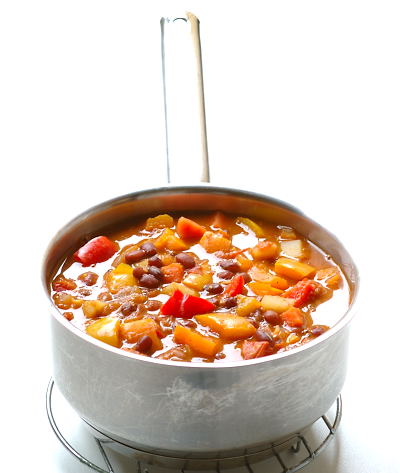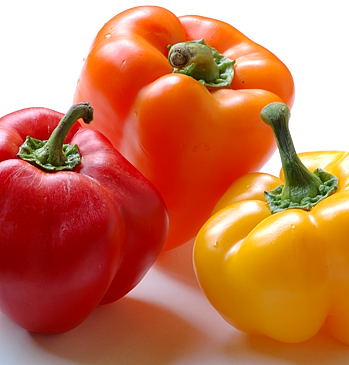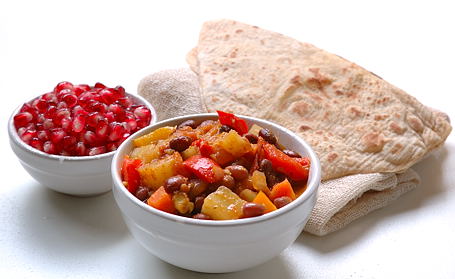
Chakalaka
African food, at least here in the west, is usually restricted to East African staples like the delicious Ethiopian dosa, the Injera or entrees such as the equally delectable Moroccan chickpea stew (normally served over couscous) common to North Africa.
But what of the quintessentially South African Chakalaka?
As one examines the recipe, it’s not hard to imagine South African cooks venturing out into their vegetable garden one hot day, picking onions, red peppers, tomatoes and any other readily available seasonal produce. As the vegetables cooked, they probably craved some of the flavors they remember smelling as they walked down a street with Indian houses. Inspired, they might have thrown in a liberal dose of curry powder into the simmering vegetables in the pot. Since many variations also include tinned baked beans, hungry laborers might have adapted it as a quick and satisfying one-pot meal at the end of a hard day of slogging it in the gold mines.
With my well-equipped Indian kitchen, Chakalaka was a breeze to whip up. Indeed, the Indian influences are not surprising. Indians have been in South Africa longer than Caucasians have been in Canada! So at least for 7-8 generations. In fact, our beloved Mahatma Gandhi cut his revolutionary teeth in South Africa.
But back to Chakalaka (don’t you just love the sound of the name?)
While the jury is still out on whether Chakalaka is a chunky ketchup or a sauce or a cooked salsa (could be either); on whether it should be served as a side dish or a condiment (served as both) and if it should be eaten hot or cold (served either way), this spicy and always vegetarian concoction has now come to be identified as the definitive taste of South Africa. There’s even a restaurant in London named for this dish. Featuring a standard base of onions, tomatoes and peppers; this versatile dish is open to endless experimentation.
Other bloggers tell us that traditionally, Chakalaka is often served as a sauce with a maize porridge (Mielie Pap) that is eaten predominantly by the local black population. It’s also served with bread or the ragi-like Samp, made of maize. It can also be spotted as an accompaniment at South African barbecues called Braais (pronounced “bry”, rhyming with the word “cry”)
In the spirit of making a mean Chakalaka that is true to its African roots as well as its spirit of assimilation and innovation, my version is based on a number of recipes found online as well as one that was featured in the Toronto star.

Red, Orange and Yellow ~ Peppers in Autumn Colors
Recipe:
(Makes enough for approx 30 tablespoon servings)
2 tablespoons of sunflower oil
1 inch piece of ginger, peeled and finely diced
2 cloves of garlic, peeled and finely diced
4 fresh green chillies, slit
1 big red onion, finely chopped
A pound (4 to 6) juicy tomatoes, finely chopped
3 bell peppers, chopped into 1cm X 1cm pieces
2 carrots and 2 potatoes chopped into 1cm X 1cm pieces
Curry powder – 1 heaped tablespoon.
Red beans – one cup, pre-soaked and pressure-cooked to tender
Salt – one teaspoon, or to taste
Fresh coriander for garnish
In a saucepan, heat up the oil and saute ginger, garlic, chillies and onions to soft. Add the salt and curry powder. Add the tomatoes and cook till mushy and of sauce consistency. Add peppers, carrots and potatoes. Cook till they are of a desired softness. Add the red beans and cook for 5-10 minutes. Remove from heat and add coriander. Check seasoning levels and serve with rice or breads of your choice.
A small confession. After adding the beans, I tasted it and found the heat was a bit too much. So I caved and added a teaspoon of jaggery at the end. Unsuspecting victims, tasters of the dish said it took them to whole new levels of delayed heat which overwhelmed the palate after the initial deceptive sweetness. But they all agreed they couldn’t get enough of it!

Chakalaka with Chapatis and Pomegranate ~ Meal Today
~ Article Contributed by Janani Srinivasan
Photos by Indira Singari.
Kitchen Notes:
Other vegetables can also be added to Chakalaka – cauliflower, zucchini, string beans etc
For curry powder – if you have access to it, I recommend the fiery Sri Lankan Niru brand powder so ubiquitous in Toronto. If not, any other store-bought or homemade will do. The South African recipes recommend a local brand called “leaf masala”.
To be true to the grassroots appeal of this dish, you could use a can of baked beans from the local supermarket. Vegetarians check labels to ensure it’s free of lard or any other animal ingredients. If you can soak your own from scratch, that’s even better.
More on Chakalaka : Chakalaka 101, and Culinary Musings from Cape Town

The title made me think like you were singing and dancing here! 🙂
Liked the name. Sounds like a cousin of minestrone to me.
Comment by RP — October 11, 2007 @ 7:35 pm
Lovely name 🙂 and equally lovely dish. very musical, shall i say 😉 and the bell peppers look so pretty!
Comment by musical — October 11, 2007 @ 7:45 pm
janani writes beautifully. we want more.
Comment by bee — October 11, 2007 @ 8:25 pm
It is so true we don’t get to learn more about African dishes other than a few. I will be happy to learn more from this series.
Comment by Suganya — October 11, 2007 @ 10:12 pm
Yes really The name i love…Thanx for sharing…!!
Comment by Rajeswari — October 11, 2007 @ 11:34 pm
When i saw your post it remindrd me the song from Bombay dreams. Shakalaka Baby……
I have never made anything from africa other than couscous and tha i think is from Moroco etc….
Your chakalka looks wonderful
Comment by Happy Cook — October 12, 2007 @ 4:36 am
Even I got reminded of the song “Shakalaka Baby”… I know nill about African cuisine… informative post I wud say.. thanks dear..:D
Comment by Siri — October 12, 2007 @ 4:59 am
Nice Chakalaka baby! I was born in Uganda, and we had something similar too. we called it Janjaare jo shaak, no peppers in the version I have on my blog, but we do use them from time to time.
Comment by saju — October 12, 2007 @ 5:24 am
Chakalaka.., interesting!!!
Comment by kalva — October 12, 2007 @ 5:57 am
This definitely looks like something Ma Ramotswe would make out of the vegetables in her garden! 🙂
Comment by Chakli — October 12, 2007 @ 7:52 am
Ratatouille, Borscht and this must be some long lost siblings (hindi films of the 70’s come to mind) 🙂
Comment by shailu — October 12, 2007 @ 10:44 am
looks yum! thanx 4 the informative post
Comment by swaroopa — October 12, 2007 @ 10:48 am
Indira, It is a feast perfect to celebrate autumn. Great job as usual.
Comment by Shri — October 12, 2007 @ 10:57 am
Indira and Janani, thanks for the lovely post.
Comment by Mamatha — October 12, 2007 @ 1:16 pm
Oh Indira! Thanks for teaching me about another lovely ‘one pot medley’ style dish.
Comment by aa — October 12, 2007 @ 1:26 pm
hi. i am currently residing in lagos-nigeria . i love to cook and have been an avid follower of your blog. i simply love the recipes, the exceptional photography and your darling cat Kittaya–i have a few of my own and one is due to deliver any day. The above mentioned dish is a meal in itself–eaten cold in the summer and hot in the winter. I like it with crusty bread. I had been to SA to attend a wedding and had a mini holiday too and got to eat this fabulous dish.
I am sharing a typical nigerian dish-,easy and tasty -–Jollof Rice. all local foods are non-vegetarian and completely no fuss–nigerians are like that–they do not like complicated things– seems like they can’t figure them out– i have omitted the chicken for you being a hard core non-veggie myself—the recipe is otherwise absolutely an original-it tastes very nice––even without the chicken—.Saute(qty.depends on you ) onions, tomatoes ,carrots cabbage and french beans in litle oil along with salt and red hot chilly peppers till onions are translucent.add a pinch of turmeric,as much rice as you want and veg. stock cubes and water/ veg stock and cook till rice is done–quite dry. sprinkle with pepper,thyme,basil. serve with cucumber wedges. nigerians eat very little oil and nearly no sugar and have the most amazing bodies i have seen anywhere in the world –firm and curvy. most of their food is eaten rare with little or no spices and fats. they take 2nd place in fat free diets. hope you like this –adapt it–looking foreward to a line in reply.
Hello Sonali,
Thank you for the lovely comment and thanks very much for sharing the Nigerian recipe. I will definitely try it at home.
All the best with the cat mama.
– Indira
Comment by sonali — October 12, 2007 @ 2:28 pm
wow janani…… that is truely an amazing south african recipe…and i was so pleasantly surprised to see it here …. great post…true … chakalaka is a must accompaniment to most SA meals…we get tinned chakalaka here too…
Comment by Rachna — October 14, 2007 @ 2:44 am
I’d say that that’s some Chakalaka baby! 🙂
Comment by Cynthia — October 14, 2007 @ 6:35 am
Nice to read about chakalka. Thanks for information on this delicious recipe.
Comment by Vishnu Rajgadia — October 14, 2007 @ 10:48 am
Chakadelic, baby!
Comment by the chocolate lady — October 14, 2007 @ 11:40 am
Hey, thanks all for your Chakadelic notes.:)
Say Chakalaka and do a “Tighten the light bulb and Twist the doorknob” kind of dance move. Have a great weekend. 🙂
Comment by Indira — October 14, 2007 @ 1:46 pm
Rick Mercer’s a funny guy, ain’t he? Thanks Indira..for that slice of quintessential Indian- Canadiana
Comment by Janani — October 14, 2007 @ 2:01 pm
Thanks very much for this lovely article Janani!
We get Vancouver station in basic cable, here at Seattle. I enjoy watching CBC, and now I am following Canadian politics also, all thanks to Rick Mercer.:)
Comment by Indira — October 14, 2007 @ 2:35 pm
I made this last night and ate it today. Like most curries, the taste improves overnight. It was YUMMY!
Comment by Gigi — October 15, 2007 @ 11:56 pm
I am South African Indian – Love the recipe!
Comment by Michelle — November 29, 2007 @ 7:42 am
You know, I have never been to South Africa but just looking at this chakalaka dish, makes my mouth watering and very hungry.I am pretty sure it is a very delicious meal.I just wish I could have a bowl right at this moment while I am cooling on my beer, but I will try to visit South Africa one day in the very near future.Keep it up South Africa, the dish looks very apetizing
Comment by Abu Bakarr Sidik Bangura — October 7, 2009 @ 8:24 pm